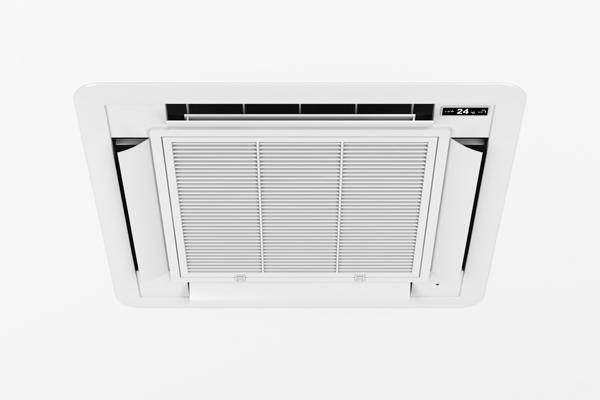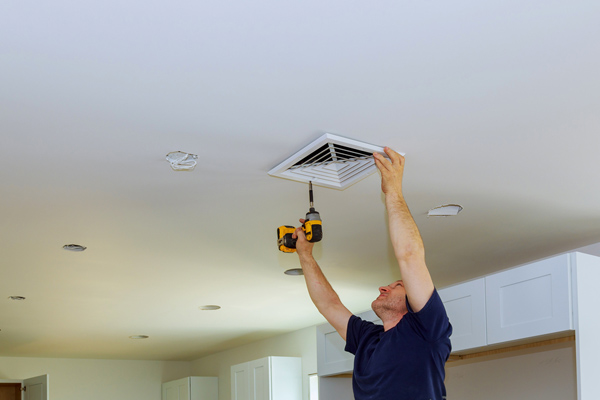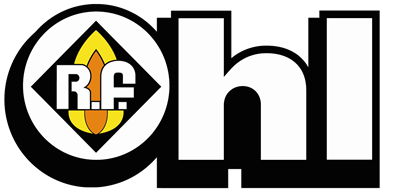What You Need To Know About Ductless Indoor Air Handlers: Ceiling Cassettes

There are multiple options when choosing an air conditioning system. Among these are window AC units, central cooling systems, and ductless mini-split units. If indoor aesthetics are important to you and you want to have a system in your home that’s virtually impossible to see, then you should consider having a ceiling cassette ductless unit installed.
What Ceiling Cassettes Are
Contents
Ceiling cassettes are a version of ductless mini-split systems in which the inside air handler is installed directly into the building’s ceiling. Much the mechanics for these units are hidden inconspicuously behind the ceiling, and the only visible element is a discreet discharge vent. This cutting-edge design makes it the ideal fit for any room, given that the unit can blend seamlessly into its surroundings.
Conditioned air can be distributed through two, three, or even four sides of a ceiling cassette unit. The outside compressor unit is mounted at the exterior of the building, very much like it would be with a more conventional mini-split design. However, the manner of this design is far more powerful than wall-mounted options. This is why ceiling cassettes are frequently used in office spaces and other commercial facilities.
The Features And Benefits Of Ceiling Cassettes
Ceiling cassettes boast a vast range of features. Among these are:
Quiet Operation
Ceiling cassettes are made with fans that have a very large diameter. This helps lower the noise level due to the greater volume of airflow that’s being pushed through this ductless unit at a significantly lower speed. Ceiling cassettes can operate as quietly as 38 dBA, which is just a bit louder than a whisper.
You Can Control Your Comfort
There are return air sensors within a ceiling cassette’s indoor air handler. These sensors can track and monitor conditions within the room so that the settings can be adjusted accordingly. As a result, you can maintain a consistent thermal preference at all hours of the day. There are also adjustable vents with this system, allowing users to send air in any direction where it’s needed.

Enjoy Better Indoor Air Quality
The air filters in many ceiling cassettes are incredibly easy to access and clean. You can take them out, wash them, and put them back in with very little trouble at all. This ensures that you don’t ever have to operate your HVAC system without the benefit of a clean filter. You can rest assured that your filters are pristine, in place, and doing what they need to do to trap contaminants and pollutants so that these are kept out of the living environment.
Beyond this, you are also able to save money, given that you won’t have to pay for regular filter replacements. These systems are designed to bring fresh outside air into your home. Rather than recycling the same stale air over and over, a ceiling cassette can draw fresh air into your home and cycle it through. Due to this fact, worries about poor indoor air quality can become a thing of the past.
Ceiling cassettes additionally can act as indoor air purifiers. You can make this possible by choosing to use photocatalytic filter types. These purification filters enable this function by helping the unit to eliminate more pollutants and contaminants from the indoor air.
Operate Your Ductless HVAC System Remotely
There is also the option to control your ceiling cassette system with a variety of controllers so that you can choose the perfect one for your lifestyle and preferences. You can use a controller to customize your settings so that the unit adheres to your thermal preferences and any other requirements that you might have.
You even have the option of using a smart controller that will allow you to adjust your system via a tablet or smartphone. With smart controllers, you’ll have the ability to manage your system even while vacationing. Also, it won’t be necessary to worry about coming home to a house that’s sweltering or freezing after you’ve been at work all day.
Additional System Features
The typical ceiling cassette doesn’t have as many features as a wall-mounted ductless HVAC. These units do have, however, a variety of features for different applications. A number of these features are reliant upon the cassette make and model. This is why it’s important for homeowners to decide which features they want and need so they can choose the best designs for their living spaces. Among some of the available features and benefits are:
- A lightweight and compact design
- The ability to release conditioned are four directions
- Modern, innovative aesthetics to seamlessly coordinate with any building interior
- The use of environmentally and ozone-friendly R410A refrigerant
The Benefits And Drawbacks Of Having A Ceiling Cassette Unit
Pros
One major advantage of having a ceiling cassette unit installed is the fact that the air in your home can be conditioned and perfectly distributed throughout the room. These systems have powerful fans that circulate the air properly through larger spaces, especially when comparing their performance to other cooling system types.
These options additionally have impressive cooling abilities. For instance, you might choose to install a ceiling cassette in a large den or family room. If you want to cool down a neighboring room, you may need to have another unit installed. In this case, a branch duct can be used as an alternative. This duct will allow some of the cooled air into the neighboring room so that both places can be conditioned with just a single unit.
Because this system has a space-saving design, it will allow you to conserve more wall and floor space. Given that the indoor air handler is installed directly in the ceiling, the unit has a very low profile as well.
Moreover, ceiling cassettes are quite energy efficient. They boast advanced technology including programmable thermostats and variable speed fans. This allows them to adjust their settings for even temperatures and virtually no energy waste.
Cons
In terms of disadvantages, it can take a significant amount of time and money to install a cassette air conditioner. This is even more true if you want to install one of these systems in a larger building. Given that the compressor must be mounted at the property exterior, the conduit line that travels between the outside compressor and indoor air handlers could be quite long. It will also mean having to have multiple holes drilled into the building walls as part of the installation process.
If you have a smaller space, a ceiling cassette may not be the best choice in this instance, either. You have to be sure that there is sufficient space in the ceiling for the installation of the indoor unit. If not, you will need to choose another HVAC system design, which may not have the same level of efficiency as a ceiling cassette.
How To Choose The Right Ceiling Cassette For Your Home
Much of the indoor unit is hidden behind the ceiling with a ceiling cassette. You will only be able to see a one-inch grill at the ceiling. If you want improved coverage from your cooling system without disrupting indoor aesthetics, then you should probably consider a ceiling cassette.
Even though these system types are commonly used in office spaces and commercial buildings, mini-split ductless options are also ideal for larger rooms. If you have hot or cold spots throughout your living area, then a ceiling cassette can help you resolve this problem. With conditioned air being released on each of the four sides, you are sure to get even air distribution throughout the space.
These are also a great choice whenever ductless, wall-mounted designs or other HVAC system types are not feasible for your space. They are guaranteed to provide high levels of energy efficiency while giving you optimum performance and control, and excellent overall comfort.

Installing A Ceiling Cassette Unit
Before having a ceiling cassette installed, you want to make sure that the unit you’ve selected fits the space. Ceiling cassette indoor units can be as small as 24 inches by 24 inches. Rafters are usually spaced about 16 inches apart in homes. If this is true for your house, then you will have to pay for customization to ensure a proper fit.
Much of the ceiling cassette is positioned just above the ceiling. As such, it must be suspended by rods or cables from an overhead edifice. To accommodate the majority of the indoor unit, the above-ceiling space needs to be at least 10 to 12 inches high.
Placement
It is common to install these systems at the center of the ceiling. This will ensure proper operation given that all four vents will be able to distribute air evenly. You also have the option of choosing a corner installation. If you do, make sure that the vents directed at nearby walls are sealed off.
Units like these come with lift pumps that eliminate the condensate resulting from the cooling cycle. A lift pump is connected to the unit exterior via a PVC pipe measuring between one and 1.25 inches.
Remember that if you’re installing a ductless ceiling cassette in a room that has not been conditioned before, insulation must be added. If you don’t add insulation, condensation can start accumulating on the exterior of the unit. This water can wind up dripping down into the actual living space. Mold and other property damages can occur as a result.
A ceiling cassette has a built-in thermostat for detecting and monitoring indoor temperatures so that output can be adjusted as needed for maintaining the desired temperature. Check to ensure that your unit isn’t installed in an area that’s naturally colder or warmer than the remainder of the space. Otherwise, inaccurate temperature readings can be taken by the thermostat, making it virtually impossible for the system to operate according to your thermal preferences.
Conclusion
You should speak with a licensed HVAC company to find out the best unit specifications for your home. A seasoned technician can help you find the best design for your needs, and install it correctly. Performing a cassette installation on your own without the proper training, knowledge, equipment, and experience can lead to a number of frustrating and costly consequences.
Check Out One Of Our Ductless Installation Projects
Ductless Panels Add Heat And AC In An Addition To A Catasauqua PA Home
Call R.F. Ohl To Learn More About Ductless Heating & Cooling Systems

If you want to discover what a ductless HVAC system can do for you, call R.F. Ohl. Our NATE-certified technicians will help you determine the type of HVAC system that works best for your needs.
R.F. Ohl is one of the region’s leading full-service HVAC companies. We offer a wide range of HVAC services, from installations and tune-ups to repairs and consultations. We can help you find different approaches and solutions to ensure that our services meet your requirements and budget. Call us today for a free, in-home estimate.
Click here to contact us today or give us a call at (610) 377-1098 if you have any questions.